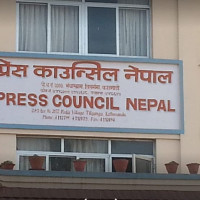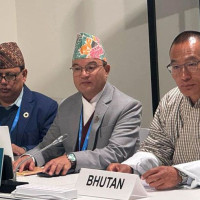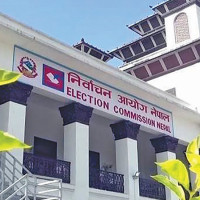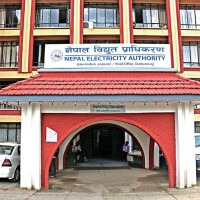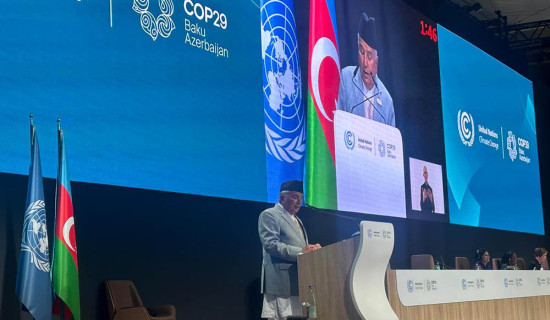- Wednesday, 13 November 2024
With decaying microfilms, National Archives losing precious records
By Binu Shrestha,Kathmandu, May 2: Historical texts and documents preserved on microfilm reels and kept at the National Archives (NA) have started decaying.
The NA has more than 1 million microfilm reels of ancient books and write-ups. Among them, 500 microfilm reels have been completely damaged because of 'vinegar syndrome' so far and many other reels have shown problems.
Jyoti Neupane, Photographic Office at the National Archives, said that the acidity that caused the ‘vinegar syndrome’ is generated in the reel containing acid. The information printed on the reel gets erased and the reels themselves dissolve due to the acid.
"We have 7,000 of these acid-based reels. Around 4,000 to 5,000 reels have been infected with acid and 500 have already been destroyed," he added.
NA has paper documents of only 20 per cent of the damaged microfilm reels, and other damaged microfilms were directly recorded from the master copies located in the villages and monasteries from across the nation, he added.
He further said that the microfilmed master copies found in villages and monasteries have also been damaged over the years
The problem had arisen 10 to 15 years ago because the microfilm could not be kept at the right temperature at the initial stage, he said.
Lack of temperature maintenance is not the only cause for the damage of the microfilm reels, it is a universal problem noticed even before the age of microfilms, he informed.
The best option of the preservation method is to keep them
following the modern technology as per time, he said.
In 2000, Proka Village in Gorkha district was completely destroyed by fire. Two months before that, the National Archives had been able to prepare the microfilms of some important local religious and historical texts.
Similarly, the four-storeyed Agam House located in the Pashupatinath temple area was destroyed by a fire on the night of June 25, 2005. The valuable books and historical documents were destroyed.
However, a few years before that, from 1998 to 1999, the Archives had documented 1,578 sets of rare manuscripts stored in the Agam House on microfilm reels. "But the old records that were saved and kept on microfilm at the time are now being lost due to inaction by higher authorities," he said.
Likewise, the Archives' team microfilmed 15,766 pages of 185 rare texts in the custody of Khumbu Monastery of Tibet, China, in 1988. Now, Neupane worried, "If the microfilms containing copies of such priceless documents continued to be lost to reel acidification, they will be lost forever."
See Page 6
Of the 500 microfilms already lost, they contained documents that were 200 to 150 years old.
National Archives (NA) is also preserving the oldest manuscripts collected from individual collections and different parts of the nation in the modern digitization system along with copying microfilm reels.
Initially, the documents and manuscripts were kept on acid-containing reels, but since 1995, they have been kept on polyester-containing reels.
To solve this problem, polyester web microfilm was developed in the 1990s. The archives have started using polyester since 1995. However, several reels in the archives have already been infected with vinegar syndrome.
The handwritten manuscripts and other documents collected from all over Nepal were kept in microfilms from 1970 under the Nepal-German Manuscripts Conservation Project.
The number of damaged reels has already reached 500. Kumar Shrestha, chief photographer of the NA, said that the number of damaged reels would increase in the coming days with the opening of other reels.
"We are making copies of reels hiring competent manpower. The existing manpower is not sufficient," he said.
Director General of the NA, Saubhagya Pradhananga, said, "We demanded allocation of Rs. 50 million to arrange all necessary things to preserve the reels," she said.
In order to protect them, in January 2015, the 'Microfilm Reel Preservation Action Plan' was submitted to the Ministry of Culture, Tourism and Civil Aviation through the Archaeology Department. But, the ministry did not pay heed to this, she said. She further said, "Even now, due to the lack of resources, conservation work has not been done."
“With our resources, we are making copies of seven to eight reels a day," said Neupane. "If we don't act quickly, there may not remain the copy of any microfilm and will get damaged within two years." The NA has hired a retired staff who has knowledge to copy information onto microfilm. A single person is not sufficient to copy the infected microfilm reels before they get completely damaged, he said.
He added, "We should be careful to protect now. If we do not protect them within one and a half years, their protection after that will be impossible. So the government should be alert now."
A very sour smell starts emanating from a reel that has started disintegrating. The eyes get irritated and one feels suffocated while entering the room where the microfilms are stored, he said. This problem is called 'vinegar syndrome' because the smell of the disintegrated microfilms matches with vinegar.
According to him, four stages of the infection have been identified so far. In the first stage, the reel starts to smell sour like vinegar. After that, the intensity of the smell gradually increases and the reel becomes brittle and wrinkled.
In the third stage, the reel becomes slick and it starts to stick and the smell becomes unbearable. In the end, the slipperiness becomes too much and the reel becomes sticky, it cannot be opened, the letters come off and melt like rubber and the reel is completely destroyed.
According to the archives, the inscriptions such as Tantra, Astrology, Ayurveda, Grammar, Rituals, Puranas, texts on Buddhism including Sanskrit, Newari, Hindi, Maithili, languages and historical documents written in Devanagari, Newari, Maithili, Kirat and Bengali scripts are preserved in the NA building.




